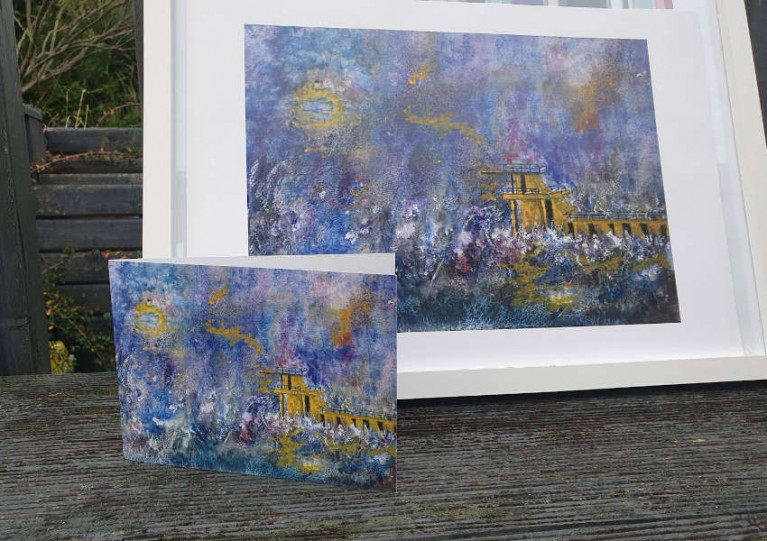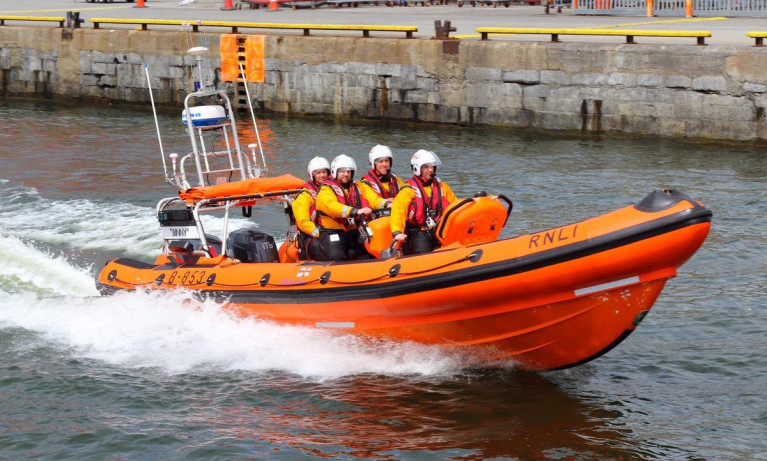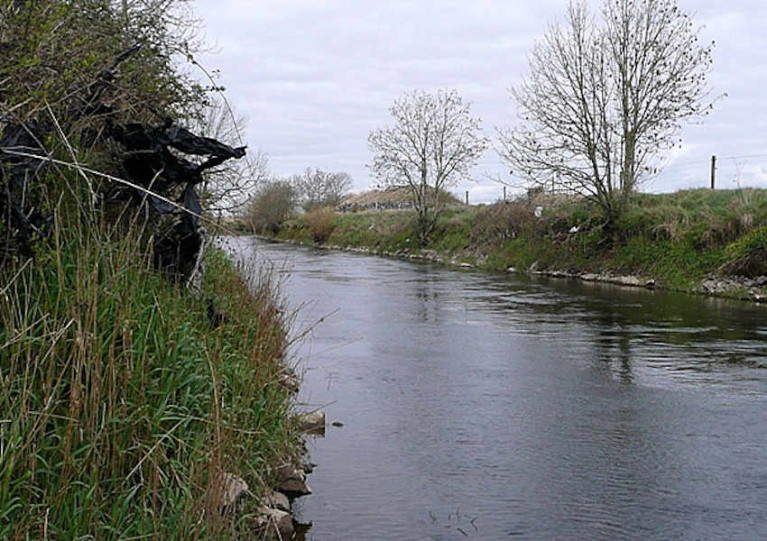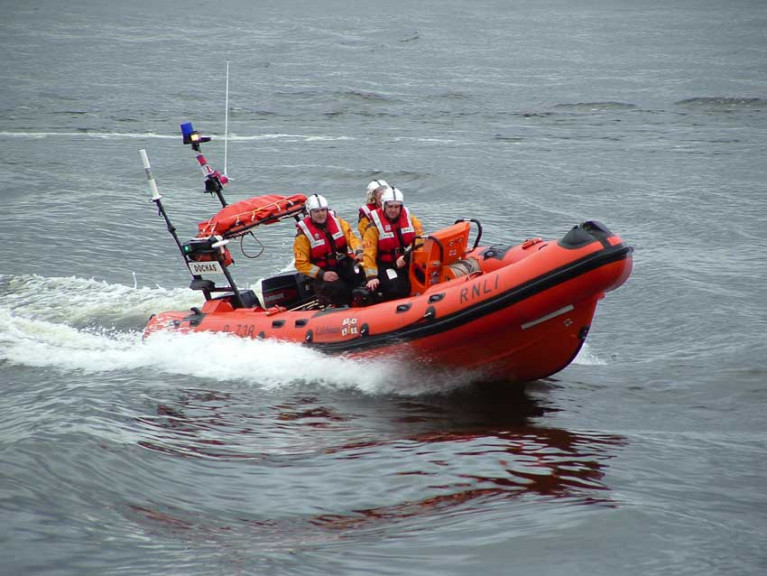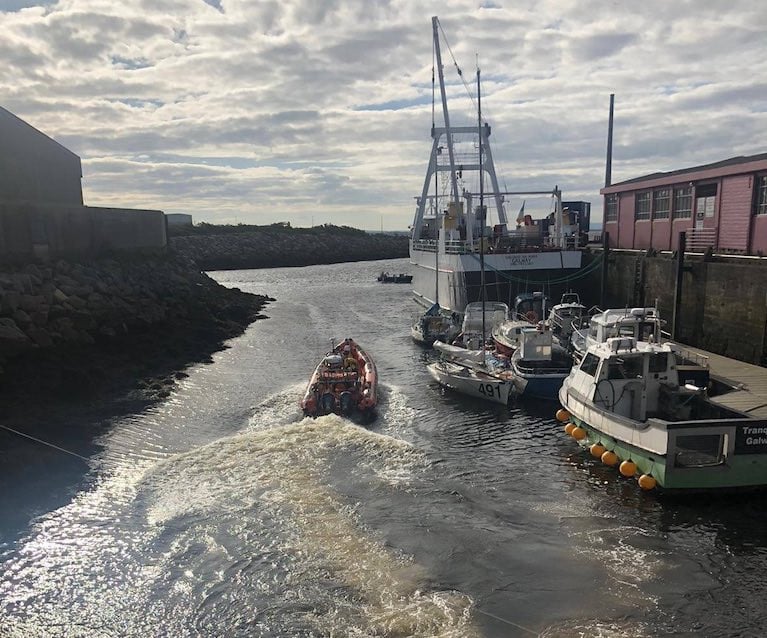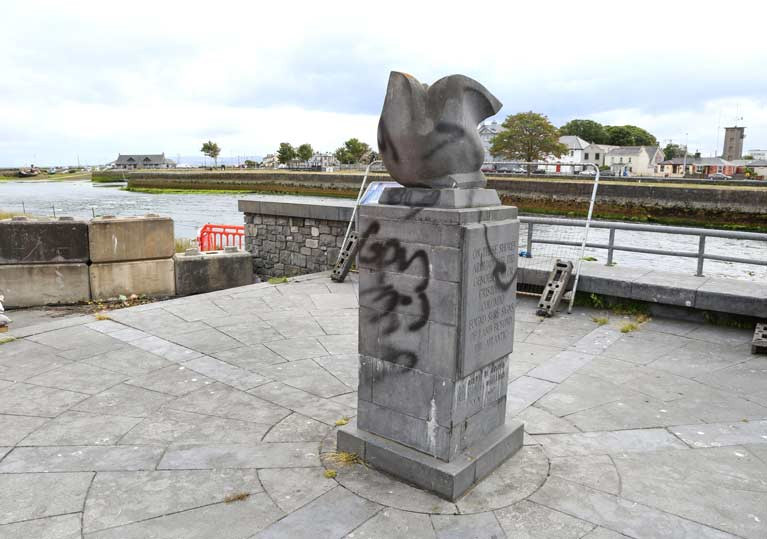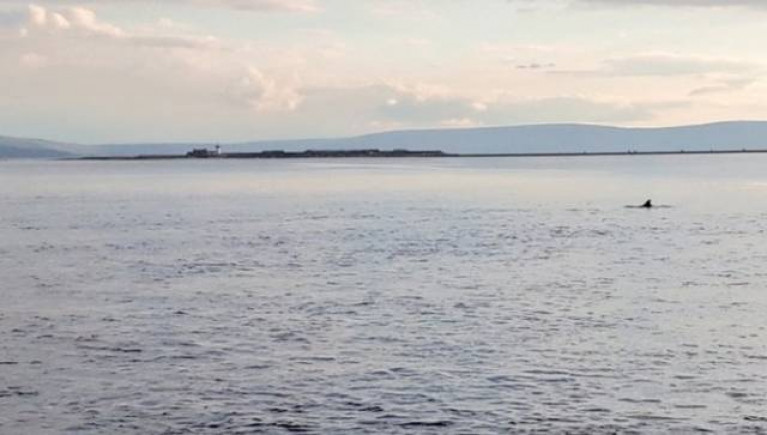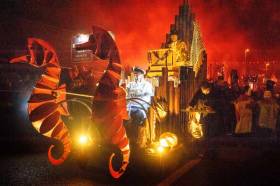Displaying items by tag: Galway
Galway to Aran Ferry's Maiden Voyage Today
Weather permitting, a flotilla of wooden-built Galway hookers will escort an aluminium-built passenger ferry out on the first leg of its maiden voyage between Galway city and the Aran islands this morning.
Several gleoiteogs with Galway Hooker Sailing Club aim to accompany the new Aran Island Ferries fast ship out past Mutton island.
As Afloat reported previously, Named Saoirse na Farraige (freedom of the sea), the 400-seat passenger ferry was built in Hong Kong for Aran Island Ferries, the company run by the O’Brien family of An Cheathrú Rua, Co Galway.
It offers a longer sea trip but faster overall journey west from Galway city to Inis Mor.
It is almost 40 years since the O’Briens took their first passengers in the Galway hooker, An Tonaí, and then purchased their first passenger ferry named the Dún Aengus in 1983.
The family company now has a fleet of five-passenger ferries, and their routes between Ros-a-Mhíl and the three Aran islands will be complemented by the new 40-metre ship on the Galway city- Inis Mór route.
The vessel built in Cheoy Lee Shipyards in Hong Kong has a speed of 20 knots, and its master is Donegal man and former pelagic fisherman Shane McCole.
It has a capacity for 394 passengers – as in a 306 passengers on the main deck, divided into two seating areas, and a semi-covered space for 88 passengers on the top deck.
However, the ferry will be carrying reduced capacity to meet with Covid-19 health and safety guidelines.
Passengers leaving for Inis Mór at 9.30am from Galway docks will have the option of a return journey via the Cliffs of Moher in Clare.
The Doolin2Aran Ferries company in Doolin, Co Clare, also offers cruises below the sea cliffs from Doolin pier.
Saoirse na Farraige claims to have “ the cleanest exhaust emission” of any ferry on Irish waters.
It is fitted leather seating, charging points and plasma screens – earning it the local nickname of “GoBus” at sea – and it has a wheelchair lift.
The O’Briens say the new route will create 15 new jobs, after what has been “a tough year for all involved in tourism”.
The Port of Galway has welcomed the first passenger ferry service from the city to the Aran Islands since 2005.
The combined Aran Island Ferries fleet of six vessels has a total facility for 1,420 passengers when at full capacity.
Ticket prices for a return journey on Saoirse na Farraige from Galway docks will be:
Adult: €49, Student/Senior: €44, Child: €25
Galway RNLI Lifeboat Rescue off Seaweed Point
Galway RNLI Lifeboat recovered a casualty from the Seaweed Point causeway off Blackrock, Salthill tonight.
The alert was raised after a member of the public contacted the authorities at about 5 pm.
The caller reported seeing a casualty at Seaweed point, off Blackrock, while out walking in the area.
The Irish Coast Guard requested the assistance of Galway RNLI Lifeboat and a member of the shore crew drove to the scene. Members of Galway Fire Service also assisted.
The lifeboat launched from Galway Docks a short time later and two crew members together with the Fire Service crew went ashore and carried the casualty on to the vessel.
He was transported back to the lifeboat station at Galway docks, where Gardai and the RNLI lifeboat medical officer assisted.
Galway Corinthians RFC Raise Over €8,500 for Galway RNLI & Cancer Care West
What started as a small fundraiser for Galway RNLI and Cancer Care West has turned into something spectacular as the players and members of Galway Corinthians RFC have raised over €8,500 for both organisations through two fundraising efforts.
The first featured the senior players in the club with Jack Noone and Kenneth Casburn behind the organisation of ‘Movember’ where players, management and committee members grew facial hair of some kind for the month of November.
The second featured the mercurial talents of club president Kieran Faherty.
Known fondly as ‘Flash’, Kieran is an accomplished artist and he generously provided one of his paintings known as ‘Brewing Up A Storm’, a stunning view of Galway Bay that has proved very popular with prints and cards selling out quickly.
But what inspired the painting? “I am often asked that,” Kieran says. “Pretty much my signature pieces are all about colour, and Connemara is my inspiration for many.
“As a kid I only saw greyness in the Connemara landscape, but age opens your eyes. Now I embrace all the wonderful changing coloured landscape that the mountains, bogs and lakes give up to us.”
He added: “I think my inspiration for this piece is the challenges it offers, as it sits in stormy waters, and I think appropriately it is raising funds for a charity that lives in stormy waters with their incredible brave crew.”
The fundraising has been warmly welcomed by both organisations, with Mike Swan, Galway RNLI lifeboat operations manager, saying: “I wanted to express my personal gratitude for the effort of the members of Corinthians Rugby Club and thank them for their very generous donation, of which will be put to good use saving lives at sea.
“Given the year that’s in it, the crew are overwhelmed with the support from the people of Galway.”
Galway RNLI Rescues Man Caught in Rising Tide
In Galway city, the RNLI inshore lifeboat rescued a man caught in rising tide while out walking at Ballyloughane beach near Renmore.
A member of the public spotted the man who had taken refuge on Hare island at about 11 am, and the alarm was raised with the Irish Coast Guard.
Galway lifeboat launched within minutes and took the man safely on board at Hare island, bringing him back to Galway docks. He did not require medical attention.
Galway lifeboat launch authority Mike Swan urged the public “ to be aware of the tide times and to take extra care when out walking any of the coastal areas around the bay so as not to get caught out”.
“Thankfully this ended well,” he said.
The Galway RNLI crew on the callout were helmsman Declan Killilea, with Stefanie Carr, Greg Cullen and Olivia Byrne.
Wild Stocks in Key Western Salmon & Trout Fisheries To Get a Boost in New Projects
Improving stocks of wild salmon and trout in the West of Ireland in the goal of a new initiative launched by Inland Fisheries Ireland (IFI).
Derek Evans writes in The Irish Times about IFI’s partnership with Co Galway angling federation Cairde an Chláir to restore a near kilometre-long stretch of the Abbert River, a tributary of the River Clare.
Earlier this year the two groups signed a memorandum of understanding on the conservation and development of brown trout and salmon and their habitat, as previously reported on Afloat.ie.
While the coronavirus pandemic slowed progress over the year, IFI says the project is now at the stage where work on the river can begin — while a similar scheme to restore 8km of nursery streams such as the River Nanny is already under way.
The Irish Times has much more on the story HERE.
Member of Well-Known Fishing Family Dies in Incident Off Galway
Indepdendent.ie reports that a member of a well-known Galway fishing family has died after an incident on a vessel in Galway Bay this afternoon (Monday 2 November).
The alarm was raised at lunchtime by a man on board the boat which was located at the time between Blackrock and Silverstrand west of Galway city.
Galway RNLI were tasked to the scene by the Irish Coast Guard, and the lifeboat crew brought the casualty back to Galway Docks from where he was transported by ambulance to University Hospital Galway.
Dismasted Yacht Rescued in Galway Bay By RNLI
Galway RNLI has rescued a man whose yacht got into difficulty on Galway Bay this morning.
Galway RNLI says that the yacht was sailing from Barna to Ballyvaughan in Clare when the forestay broke and the mast crashed onto the deck.
The man was alone on the yacht and contacted the Irish Coast Guard which tasked sought the Galway inshore lifeboat at about 9.27 am.
It launched within minutes, and located the yacht off Furbo. The crew took the man on board and towed the yacht to Spiddal.
Galway Lifeboat deputy launch authority Shane Folan said the rescue was “not without difficulties”.
“There was a south west wind force four to five, a sea swell of one and a half to two metres, but thankfully we got the vessel safely to Spiddal,”Folan said.
The RNLI crew involved were helmsman Martin Oliver, Sean King, Lisa McDonagh and Greg Cullen.
Damage to Columbus Monument in Galway Condemned
A former Italian honorary consul has expressed disappointment at damage to a monument marking explorer Christopher Columbus’s links to Galway.
A Labour city councillor, Niall MacNelis, has also condemned the spraying of black paint on the monument, and says he has reported the matter to the Garda Siochána.
Adriano Cavalleri was honorary consul to Galway when the monument was unveiled in 1992 to mark the 500th anniversary of Columbus’s voyage to the Americas.
Mr Cavalleri explained it was intended to celebrate the navigation skills of Columbus and his crew, and the fact that he is believed to have docked in Galway port in 1477.
Late Italian historian and Columbus biographer Paolo Emilio Taviani had established that Columbus had called to the port and received chart information, Mr Cavalleri said.
“We wished to celebrate these maritime skills, and the link between Galway and Genoa where Columbus was from,” Mr Cavalleri said.
The Columbus monument was donated by the city of Genoa, and its installation close to the Spanish Arch was supported by the Italian Cultural Institute.
Earlier this week, People Before Profit called on Galway City Council to remove monuments which “glorified slavery and racism”, including the Columbus monument.
It also criticised a plaque in Tuam honouring Major Richard (Dick) Dowling who served with the Confederate Army in the US.
Cllr MacNelis said that conflating Columbus’s visit to Galway in 1477 with slavery did “no service to the Black Lives Matter campaign”.
“If this is the approach, where do we stop – does this mean we don’t remember the Galway soldiers who lost their lives while fighting abroad,” Cllr MacNelis said.
Nimmo The Bottlenose Dolphin Heralds Spring In Galway City
The traditional first day of spring in Ireland also saw the return of Nimmo, a bottlenose dolphin who’s become a regular visitor to Galway city.
The Irish Whale and Dolphin Group (IWDG) says this is the sixth consecutive year for this particular dolphin, who has stayed for anywhere between four and eight months since 2016.
As reported this time last year on Afloat.ie, Nimmo’s predilection for Galway Harbour is a sign that the area has become an important feeding habitat.
“This is a wonderful opportunity for people in Galway to observe a wild dolphin close to a city centre and often within clear view of the shoreline,” says IWDG sightings officer Pádraig Whooley.
He also calls on local citizen scientists and marine wildlife watchers to submit their own sightings over the coming months.
Conamara Sea Week Parade Tonight at Letterfrack, Galway
Giant “fire sculptures”, a community dinner, jazz lunch and a walk to Omey island are among activities planned for Conamara Sea Week’s programme based in and around the Quaker village of Letterfrack.
Ecologist Gordon D’Arcy is participating in a schools programme, and students from primary to third level have created images for the “After the Light” parade tonight, Wed October 23rd, from 7pm.
The award-winning festival, which has been running since 1984, is focused on the community, with a strong environmental focus.
“Myth, magic and a hint of madness” is promised for the mid-week parade, involving students from five primary schools, local crèches, Youthreach, Galway-Mayo Institute of Technology (GMIT) Letterfrack, the Galway Roscommon Education and Training Board and the Brothers of Charity.
An “active age club” lunch and music at Rosleague Manor takes place on Thursday, October 24th, and that same evening a community dinner in Veldon’s Seafarer will offer food made by award-winning chef Jonathan Keane of the Lodge at Ashford.
Artist Mo West will open a sea week “small works” art exhibition at Connemara National Park on Saturday (Oct 26), and John O’Halloran will lead a walk on Sunday to Omey island, meeting at Claddaghduff church at 10.30am.
The programme, including music of all genres, continues until bank holiday Monday, and further information is available by phoning 085 1154629 or check the website here



























